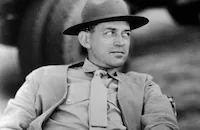Based on a play by H.R. Harwood, Personal Property was previously made by MGM in 1931 as The Man in Possession with Robert Montgomery and Irene Purcell. For the remake, Harlow was paired with up and coming studio golden boy, Robert Taylor. Clearly being groomed by MGM for stardom, Taylor had already been paired with almost every leading lady on the lot, including Janet Gaynor and Joan Crawford. Taylor headed into filming for Personal Property directly off his success in Camille (1937) with Greta Garbo. Taylor and Harlow first teamed up for Cecil B. DeMille's Lux Radio Theater of the Air on December 14, 1936. Claude Rains joined the pair in a shortened performance of Madame Sans-Gene, a comedy set during the French Revolution.
The other man in Harlow's life in December 1936 was boyfriend William Powell. Just before Christmas, Powell presented Harlow with an 85-carat star sapphire ring. Harlow was ecstatic. When reporters asked her if the engagement was official, Harlow replied, "It is as far as I'm concerned!" Powell was less committal, hurting Harlow's feelings when he commented, "I knew she'd like [the ring]. It's so vulgar." Still, Harlow wore the sapphire. She even wore it during the filming of Personal Property, despite the fact that her character was a penniless widow. At one point during the film's production, Harlow lost her ring, removing it for a dishwashing scene and handing it to a makeup man. An all night search finally turned up the ring in an ashtray.
Late nights were nothing uncommon on the set of Personal Property. Director Woody "One Take" Van Dyke pushed the production through in less than two weeks. No retakes were allowed to the point that once, when Harlow lapsed into a minor coughing fit, the scene was not reshot. The cast had a good incentive to finish the film quickly and on time. They'd been invited to President Roosevelt's birthday party in Washington. Louis B. Mayer, unable to turn down the free publicity, gave his consent for the trip provided Personal Property wrapped in time.
And indeed, as soon as filming was complete, Harlow and Taylor boarded a D.C. bound train, their suitcases full of evening wear from the film. Five gallon bottles of spring water also made the trip, which were used to wash Jean's hair. Unfortunately Jean fell ill on the return trip, never completely recovering her strength from a bad case of the flu. Photographer George Hurrell noticed the differences in Harlow following her trip to Washington. "She looked heavier," he noted. "And she faded fast."
Sadly, Hurrell was right. Jean died on June 7, 1937. Personal Property was re-released soon after. It took in $1.8 million at the box office.
Producer: John W. Considine, Jr.
Director: W.S. Van Dyke
Screenplay: H.M. Harwood (play The Man In Possession), Hugh Mills, Ernest Vajda
Production Design: Edwin B. Willis
Cinematography: William H. Daniels
Costume Design: Dolly Tree
Film Editing: Ben Lewis
Original Music: Edward Ward (uncredited), Franz Waxman
Principal Cast: Jean Harlow (Crystal Wetherby), Robert Taylor (Raymond Dabney), Reginald Owen (Claude Dabney), Una O'Connor (Clara), Henrietta Crosman (Mrs. Dabney).
BW-84m.
by Stephanie Thames


























